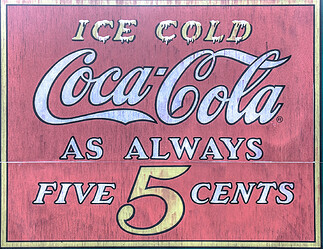Kind of grunching because this is a fascinating story. (The Coke part. Yes, Pepsi owns its bottling group.)
It’s true that Coca Cola sold the bottling rights for a dollar. But what’s fascinating is that the sale was at a fixed price with no expiration date. So as Coca Cola got more and more popular, and as price inflation continued up and up, Coke was in a shitty position. There was a lot of pricing power in Coke’s brand, as people were willing to pay higher prices for it, but Coke itself wouldn’t benefit from increasing prices. The bottling group would capture any price increases, while Coke was stuck with that same fixed price. From Coke’s perspective, the best thing to do would be to keep a low consumer price to maximize the volume of Coke sold. But Coke couldn’t control the prices that the bottlers charged.
Imo, Coke’s solution was genius. They couldn’t directly force the bottlers to maintain a low end price. So instead, all of Coke’s advertisements promised a nickel price:
Now, Coke couldn’t actually enforce this nickel price, but the bottlers and retailers complied with this pressure and kept their prices low in order to prevent consumer backlash. So Coke’s advertising ultimately maintained the pricing authority that Coke didn’t formally have, and they ended up renegotiating that terrible original contract.
You can see this and other information here: Fixed price of Coca-Cola from 1886 to 1959 - Wikipedia
My favorite part of this is that Coke was largely stuck with this five cent pricing with vending machines because:
- Coke vending machines couldn’t make change
- Coke believed that consumers would be less willing to buy from a vending machine if they needed multiple coins (a nickel is easy, but six or seven cents is more of a pain in the ass)
So their only perceived solution was to raise the price to a dime, but a doubling in price was out of the question. So they lobbied the US Treasury to mint a 7.5 cents coin in order that would allow them to increase prices by 50%. Their alternative solution was so logical yet stupid that an academic must have thought of it:
In another attempt, The Coca-Cola Company briefly implemented a strategy where one in every nine vending machine bottles was empty.[1] The empty bottle was called an “official blank”.[2] This meant that, while most nickels inserted in a vending machine would yield cold drinks, one in nine patrons would have to insert two nickels in order to get a bottle. This effectively raised the price to 5.625 cents.
There’s a lot of other interesting Coke/Pepsi stuff that doesn’t belong in this thread:
- The accounting treatment of Coke and Pepsi bottling investments was super interesting and was a long-time financial statement analysis case. Basically, the two companies owned enough of the bottlers to maintain control, but not enough that they showed up on the financial statements.
- The big Coke recipe secret - It’s in a secret vault and no single executive knows the entire recipe - is nonsense. Pepsi can perfectly create Coke and vice versa if they wanted to.
- The Pepsi challenge was true - people really did enjoy Pepsi more than Coke in a blind test. But that’s only for the initial hit, which is why the Pepsi challenge was conducted with small amounts. Coke is designed so that people enjoy large amounts of it without getting sick of it, which apparently is an attribute that colas have but other beverages like root beer do not.
Happy to talk more about this stuff, but probably not in this thread.
